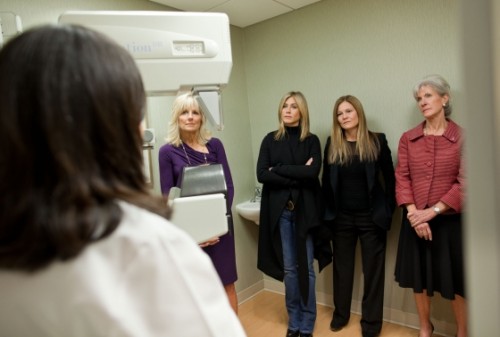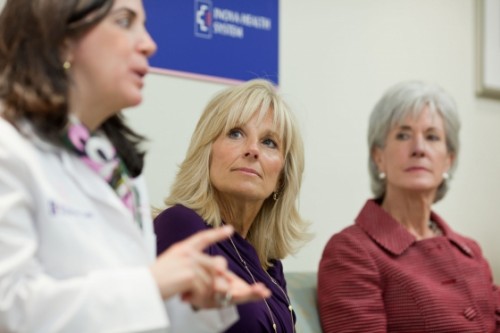Reaffirming Our Commitment to Fighting – and Preventing – Breast Cancer
Reaffirming Our Commitment to Fighting – and Preventing – Breast Cancer
October is National Breast Cancer Awareness Month – a time to remember those who have lost their lives to breast cancer and those who are battling it now, and to celebrate with those who have survived. It is also a time to reaffirm our commitment to fighting breast cancer and to remind ourselves of the importance of prevention and early detection.

The North Portico exterior of the White House is illuminated pink, Oct. 3, 2011, in honor of Breast Cancer Awareness Month. (Official White House Photo by Lawrence Jackson)
Breast cancer remains one of the most frequently diagnosed cancers among American women and despite remarkable advances in treatment and prevention, it remains the second leading cause of cancer death.

- Dr. Jill Biden, along with Jennifer Aniston, Kristin Hahn, and Secretary of Health and Human Services Kathleen Sebelius, listens to Dr. Constanza Cocilovo during a tour of the Inova Breast Care Center in Alexandria, Va., Oct. 3, 2011. (Official White House Photo by Chuck Kennedy)
Regular mammography screenings help ensure that breast cancer does not take the lives of more women. The chance of successful treatment is highest when breast cancer is detected early. However, only about 67 percent of women aged 40 or older have had a mammogram in the last two years. If 90 percent of women 40 and older received breast cancer screening, 3,700 lives would be saved each year. Yet in a time when budgets are tight, costs – even moderate co-pays – deter many patients from receiving these important screenings.
Thanks to the health reform law, the Affordable Care Act, most private health plans and Medicare now cover women’s preventive health care – such as mammograms and screenings for cervical cancer –with no co-pays or other out-of-pocket costs. This means that women can get services they need to detect or prevent breast cancer before it spreads or becomes fatal, without worrying that they’ll have to pay for these services out of their own pockets. This year to date, 3.8 million women in traditional Medicare have gotten a free mammogram.
In addition to regular mammography screenings, there are steps that women can take that may reduce their risk of developing breast cancer. Women should talk with their doctor about their personal risk for breast cancer, when to start having mammograms, and how often to have them. If they are found to be at increased risk of breast cancer because of medical or genetic history, they should talk with their doctor to decide what the best options are to reduce their breast cancer risk. With the release of the new Women’s Preventive Services Guidelines, a well-woman visit is available so women have the opportunity to discuss their health care needs with their medical provider—at no additional cost.
Women also have new rights and protections against insurance company abuse under the Affordable Care Act. If diagnosed with breast cancer or another illness, women are now protected from having their coverage taken away if they get sick and when they need coverage the most.
The health reform law is also helping women who are going, or have gone through, costly breast cancer treatment. Today, insurance companies can’t impose lifetime limits on coverage. And in most health plans, annual limits will be restricted. This means that your health insurance will be there right with you, covering your treatments, as long as you need it.

- Dr. Jill Biden Secretary of Health and Human Services Kathleen Sebelius participate in a discussion on breast cancer prevention at the Inova Breast Care Center in Alexandria, Va., Oct. 3, 2011. (Official White House Photo by Chuck Kennedy)
Beginning in 2014, it will be illegal for insurance companies to discriminate against anyone with a pre-existing condition. In the past, insurance companies could deny coverage to women due to pre-existing conditions such as breast cancer, and if coverage was attained, insurance companies set lifetime and annual limits on what the companies would spend for benefits.
These changes are making real differences in the lives of American women and families. Prevention, coupled with continued research, will help save more lives and improve the quality of life for all of us touched by breast cancer.

- The North Portico exterior of the White House is illuminated pink, Oct. 3, 2011, in honor of Breast Cancer Awareness Month. (Official White House Photo by Lawrence Jackson)
________________________________________________________________
![]()
* The above story is adapted from materials provided by USA Department of Health and Human Services (HHS)
** More information at USA Department of Health and Human Services (HHS)



















